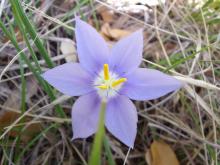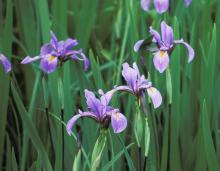Wildflowers, Grasses and Other Nonwoody Plants
Media

Species Types
Scientific Name
Nemastylis geminiflora
Description
Celestial lily, in the iris family, blooms only in the morning. Its showy, lavender-blue flowers shine like six-pointed stars on glades and prairies in southern Missouri and the eastern Ozarks.
Media

Species Types
Scientific Name
Sisyrinchium campestre
Description
It has grasslike leaves, but it’s not a grass. In fact, it’s in the same family as the common garden iris! Four species of blue-eyed grass grow in Missouri, and this one, often found on prairies, glades, and pastures, is the most common.
Media

Species Types
Scientific Name
Hypoxis hirsuta
Description
Yellow star grass grows throughout the tallgrass prairie region. Imagine the thoughts of pioneers when they gazed upon these bright little lilies during stops along their westward journey!
Media

Species Types
Scientific Name
Iris virginica
Description
Ten species of iris grow wild in our state, but only four of them are native. Of our native irises, this one is the most common. But drainage “improvements” are eliminating the habitat of this beautiful wetland wildflower.
See Also
About Wildflowers, Grasses and Other Nonwoody Plants in Missouri
A very simple way of thinking about the green world is to divide the vascular plants into two groups: woody and nonwoody (or herbaceous). But this is an artificial division; many plant families include some species that are woody and some that are not. The diversity of nonwoody vascular plants is staggering! Think of all the ferns, grasses, sedges, lilies, peas, sunflowers, nightshades, milkweeds, mustards, mints, and mallows — weeds and wildflowers — and many more!





















